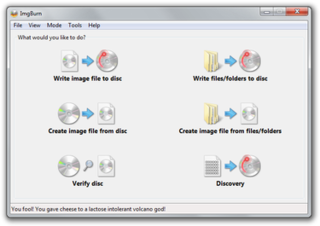
In computing, an optical disc drive is a disc drive that uses laser light or electromagnetic waves within or near the visible light spectrum as part of the process of reading or writing data to or from optical discs. Some drives can only read from certain discs, but recent drives can both read and record, also called burners or writers. Compact discs, DVDs, and Blu-ray discs are common types of optical media which can be read and recorded by such drives.
An optical disc image is a disk image that contains everything that would be written to an optical disc, disk sector by disc sector, including the optical disc file system. ISO images are expected to contain the binary image of an optical media file system, including the data in its files in binary format, copied exactly as they were stored on the disc. The data inside the ISO image will be structured according to the file system that was used on the optical disc from which it was created.

Alcohol 120% is a disk image emulator created by Alcohol Soft. It can create and mount disc images in the proprietary Media Descriptor File format. Images in this format consist of a pair of .mds and .mdf files. Alcohol 120% can also convert image files to the ISO format. Alcohol Soft has cited it will not be developing an image editor for Alcohol 120%.

A disk enclosure is a specialized casing designed to hold and power disk drives while providing a mechanism to allow them to communicate to one or more separate computers.

The USB mass storage device class is a set of computing communications protocols, specifically a USB Device Class, defined by the USB Implementers Forum that makes a USB device accessible to a host computing device and enables file transfers between the host and the USB device. To a host, the USB device acts as an external hard drive; the protocol set interfaces with a number of storage devices.
SafeDisc is a copy protection program for Microsoft Windows applications and games distributed on optical disc. Created by Macrovision Corporation, it was aimed to hinder unauthorized disc duplication. The program was first introduced in 1998 and was discontinued on March 31, 2009.

Professional Disc (PFD) is a digital recording optical disc format introduced by Sony in 2003 primarily for XDCAM, its tapeless camcorder system. It was one of the first optical formats to utilize a blue laser, which allowed for a higher density of data to be stored on optical media compared to infrared laser technology used in the CD and red laser technology used in the DVD format.

UltraISO is a crippleware application for Microsoft Windows for creating, modifying and converting ISO image files used for optical disc authoring, currently being produced by EZB Systems.
A cue sheet, or cue file, is a metadata file which describes how the tracks of a CD or DVD are laid out. Cue sheets are stored as plain text files and commonly have a .cue filename extension. CDRWIN first introduced cue sheets, which are now supported by many optical disc authoring applications and media players.
A CloneCD Control File is a text descriptor with the extension .ccd used by CloneCD to mark the properties of a CD/DVD image. These files need to be combined with an image file to be burned. It may also come with a subchannel file.

ImgBurn is an optical disc authoring program that allows the recording of many types of CD, DVD and Blu-ray images to recordable media. Starting with version 2.0.0.0, ImgBurn can also burn files and data directly to CD or DVD. It is written in C++. It supports padding DVD-Video files so the layer break occurs on a proper cell boundary.

CDemu is a free and open-source virtual drive software, designed to emulate an optical drive and optical disc on the Linux operating system.

Target Disk Mode is a boot mode unique to Macintosh computers.
An NRG file is a proprietary optical disc image file format originally created by Nero AG for the Nero Burning ROM utility. It is used to store disc images. Other than Nero Burning ROM, however, a variety of software titles can use these image files. For example, Alcohol 120%, or Daemon Tools can mount NRG files onto virtual drives for reading.

CDRWIN was a CD/DVD burning software for Microsoft Windows developed by Golden Hawk Technology company.
It progressed from lone wolf Jeff Arnold's hobby to a full-blown recording software that equals the power, performance, and features of many of the programs from the big boys.
Media Descriptor File (MDF) is a proprietary disc image file format developed for Alcohol 120%, an optical disc authoring program. Daemon Tools, CDemu, MagicISO, PowerDVD, and WinCDEmu can also read the MDF format. A disc image is a computer file replica of the computer files and file system of an optical disc.

MagicISO is a CD/DVD image shareware utility that can extract, edit, create, and burn disc image files. It offers the possibility of converting between ISO and CUE/BIN and their proprietary Universal Image Format disc image format.
Notable software applications that can access or manipulate disk image files are as follows, comparing their disk image handling features.

AcetoneISO is a free and open-source virtual drive software to mount and manage image files. Its goals are to be simple, intuitive and stable. Written in Qt, this software is meant for all those people looking for a "Daemon Tools for Linux". However, AcetoneISO does not emulate any copy protection while mounting.
The Advanced Disc Filing System (ADFS) is a computing file system unique to the Acorn computer range and RISC OS-based successors. Initially based on the rare Acorn Winchester Filing System, it was renamed to the Advanced Disc Filing System when support for floppy discs was added and on later 32-bit systems a variant of a PC-style floppy controller.













